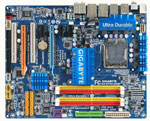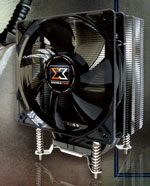Intel Value Midrange
While Intel still owns the very top in CPU performance, the Phenom II has made AMD competitive in the upper midrange to the low high-end. As higher speeds are introduced for Phenom II, that CPU parity will likely move up the CPU scale. That means that midrange to low high-end is now also an area where you can choose Intel or AMD based on the unique features of each platform or expansion capabilities, rather than one brand dominating performance.
The Intel Value Midrange is built around a fast Intel Core 2 Duo CPU. For most applications and gaming, a faster Core 2 Duo is normally a better performance choice than a slower quad-core. CPU intensive applications like video manipulation do benefit from a quad-core CPU, which should be your choice if those applications are important to you. A few recent games are finally taking advantage of quad-core as well.
| Intel Value Midrange PC | ||
| Hardware | Component | Price |
| Processor | Intel Core 2 Duo E8500 Wolfdale (3.16GHzx2, 6MB L2) |
$188 |
| Cooling | XIGMATEK HDT-S1283 120mm Rifle CPU Cooler | $37 |
| Video | SAPPHIRE 100259-1GB Radeon HD 4870 1GB | $230 |
| Motherboard | Gigabyte GA-EP45-UD3P | $137 |
| Memory | OCZ Reaper 4GB (2 x 2GB) DDR2-1066 Dual Channel Kit, | $46 |
| Hard Drive | Seagate Barracuda 7200.11 ST31000333AS 1TB | $110 |
| Optical Drive | LG BD/HD DVD / 16x DVD+/- RW GGC-H20LK | $99 |
| Audio | Creative Sound Blaster X-Fi Xtreme Audio 7.1 Channels 24-bit 96KHz PCI | $50 |
| Case | COOLER MASTER RC-690-KKN1-GP ATX Mid Tower | $80 |
| Power Supply | PC Power & Cooling S75CF 750W SLI CrossFire Ready 80 PLUS Certified | $80 |
| Display | Acer H213H bmid Black 21.5" 5ms HDMI Widescreen 16:9 Full HD 1080P LCD Monitor (1920x1080) | $199 |
| Speakers | Logitech X-540 70 watts 5.1 Speaker - Retail | $79 |
| Input | Microsoft CA9-00001 Black PS/2 Standard Keyboard and Optical USB/PS2 Mouse - OEM | $16 |
| Operating System | Microsoft Vista Home Premium OEM | $99 |
| Bottom Line | $1450 | |
 |
The CPU is one of the fastest Core 2 Duo chips on the market. The E8500 at 3.16GHz is just one step below the fastest Core 2 Duo E8600 which clocks at 3.33GHz. It also overclocks exceptionally well, reaching 4GHz and even higher with relative ease. Because of this OC ability and the value goal of this system build, the E8500 has been matched with components that are also excellent choices for overclocking. The E8500 is plenty fast on its own, but if overclocking interests you this Intel Value Midrange will be ready for action - and ready to overclock to wherever your particular E8500 can go.
 |
The big brother to the UD3R selected in our under $1000 guide is the $137 Gigabyte GA-EP45-UD3P that has a similar feature set but adds a second x16 slot (in place of a PCI slot) for dual x8 CrossFire operation. The board provides an excellent overclocking platform along with great stability. If the second x16 slot is not important to you, we suggest sticking with the UD3R. This P45 chipset motherboard has earned its reputation as a sterling overclocker, while also maintaining excellent stability. It is a good match to the selected Core 2 Duo E8500 or an alternate quad-core Q8200 (2.33GHz).
 |
While the stock Intel cooler is adequate for modestly overclocking a Core 2 Duo, better cooling is needed to push the CPU to its limits. The Xigmatek HDT-D1283 120mm Rifle Cooler did very well in our cooling tests and it is a good match to the E8500. OCZ also markets a similar 120 Rifle cooler and either should work well in this system.
For this Value Midrange system, faster memory with more overclocking headroom was chosen. With the current OCZ rebates some of their best memory is available at truly bargain prices. The choice for the Intel system is an OCZ Reaper 4GB DDR2-1066 (PC28500) kit. With attached heatspreaders and the unique Reaper heatpipes and external heatsink, this 4GB kit is ready for overclocking. The base specs of DDR2-1066 at 5-5-5-18 are also impressive even if you never overclock. Value is good at the normal $76, but with the current $30 rebate the price is an easy-on-the-budget $46.










77 Comments
View All Comments
7Enigma - Monday, January 12, 2009 - link
I've never heard of this and 20min of searching Anandtech doesn't show it in any CPU cooler roundups that I can find? The Xigmatek AIO or something does show up but clearly this is a different part. Could someone link me to an Anand article that has a review of it?7Enigma - Wednesday, January 14, 2009 - link
Anyone interested see Christof's reply on (now) page 6. Apparently while never written up in an Anand article the cooler was tested in-house and did very well for the $.7Enigma - Wednesday, January 14, 2009 - link
*Mr. Fink was actually the person whom tested the cooler. Edit button, EDIT BUTTON, G-D edit button!7Enigma - Monday, January 12, 2009 - link
$190 E8500$165 E8400
Is there any real benefit to the E8500 over the E8400? I plan on a modest OC, likely not looking to increase the voltage (maybe slightly), is there something I'm missing since the stock frequency seems to be under 200MHz, and the cache size is the same?
Thanks.
Jynx980 - Monday, January 12, 2009 - link
Good guide. I am planning on building a similar system as the Intel Midrange system. I would like to see power draw and acoustic info though. Why are the CPU heatsinks referred to as Rifle coolers?Typo?:the E8600 has been matched with components that are also excellent choices for overclocking.
Jynx980 - Monday, January 12, 2009 - link
I am also curious if CPU and video card prices will get a bit of a shuffle soon with the new Phenom and GTX 295.jasonb - Monday, January 12, 2009 - link
Phenom II is 4x 512 KB, not 4x 512 MB.IHateMyJob2004 - Monday, January 12, 2009 - link
I would love to have someone write up an article (or articles) that revolves around the idea of data storage at home.these days, my concerns are with the following:
1) perosnal finances
2) images (digital cameras are popular these days)
3) videos ($300 for a good digital camcorder)
4) music (all those with iPods step forward)
None of this is processor heavy, but requires alot of disk space. And since alot of important data is on there, backups are also needed.
So, maybe come up with various price points with requirements for backup.
Low end could be simple backup on an external drive.
Mid end could be the same but with more storage
High end could be crazy (raid 0+1?) and include multiple backups.
And some sort of plan for offsite backup (optional) for each build. The high end could use an online service while the low end could just include an extra external hard drive which is kept at another location.
System builds like this do not exist and I want it and I'm sure alot of us ex-gamers (now 30+ year old parents) have much different concerns than the college crowd.
garydale - Monday, January 12, 2009 - link
OK, I can appreciate that a lot of people are looking for game machines, but there are also those of us who are looking for machines to do office work, touch up pictures, and edit home videos. Moreover, if you're not stuck on Windows, you can try other things that can give you a nice performance boost.None of the machines here use what I consider to be all but obligatory nowadays - a RAID array. Of course, using Linux makes setting up a nice 3-disk or 4-disk RAID5 array easy and cheap. And it really boosts your read performance, something even gamers can appreciate. Since HD access is a real bottleneck, going for a RAID array makes sense.
Secondly, how about going to a real 64bit operating system? Even the 64bit Vista usually has you running 32bit programs. With Linux however you get 64bit right the way through without having to worry about driver or program compatibility (I'm running Debian/Lenny on my workstation which, although still in "testing", is far more stable than the antique XP, let alone Vista).
Admittedly, 64bits doesn't always buy you a lot of extra performance, but in the real world, it's a free upgrade. And sometimes it can get you a big payback while it rarely costs you any performance.
Anyway, I consider my system to be midrange but it costs less than the lower cutoff point, with the 3 HDs, quad-core processor and (if I needed a new one) display being the only expensive parts. Since I'm not a gamer, I didn't bother with a video card. The onboard video handles full-screen HD video nicely so why bother? This also allows me to use the wonderfully economical and quiet PC Power & Cooling Silencer 370 power supply.
Another cost savings is to use a KVM switch instead of a monitor. Some people are connecting multiple monitors up to a single computer, so obviously this isn't a general solution, but with Linux providing multiple virtual desktops, I find that a single monitor for multiple machines works well. And certainly a reasonable KVM saves money and desk space over multiple keyboard, mouses and monitors.
7Enigma - Monday, January 12, 2009 - link
Mr. Fink,Can you recommend a good PSU in the 500-550w range? I've been waiting for the 2nd part of the PSU reviews that have that range as I feel the 750w is overkill for my single gpu build. Maybe send Mr. Katzer an email since he did the 350-400 article?